Articles and Features
Off the Beaten Track: The World’s Most Remote Art Installations
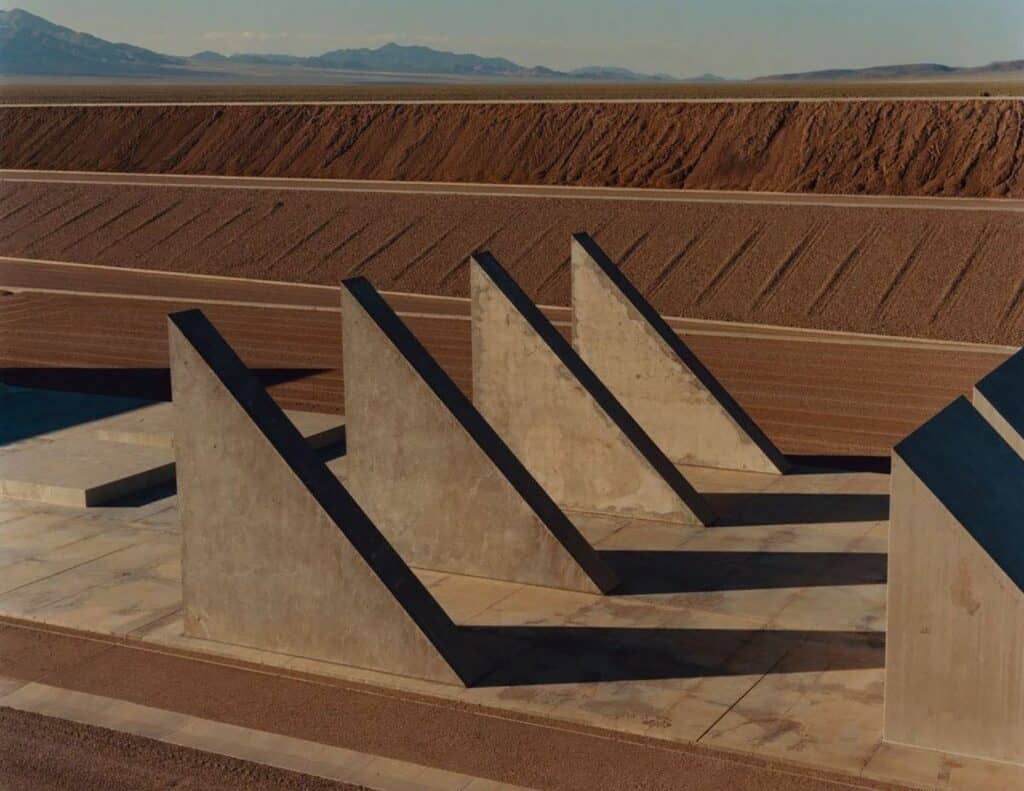
By Adam Hencz
“In the end I’m lucky it took this long. It’s like a handmade object now, erased, redone, adjusted, not just fabricated. It’s part of nature, here for millennia.”
Michael Heizer
As the world is opening up and we are able to travel more freely again, this time is also a new momentum to reconsider where and how we imagine to experience art in the future. In a world of blockbuster art shows and museum selfies, there is a need for the kind of art experience that connects more authentically with a place, and nature in particular. Artists have created incredible works of art even in the furthest corners of the world; in the middle of the deserts of the American Southwest and Australia, on remote Japanese islands or even beyond the Arctic circle. From colossal life’s works of prodigious land artists like Walter De Maria or Michael Heizer, through celebrated contemporary artists like Louise Bourgeois and Yayoi Kusama these hidden installations and structures repurpose the natural landscape and revive abandoned man made sites. This week Artland uncovers the most unusual places around the world to see the world’s most remote art installations.
1. Walter De Maria, The Lightning Field (1977)
Carton County, New Mexico, USA

Recognized for his massive and large-scale installations that explored the issues of time and space on a grand scale, Walter De Maria was one of the most notable contributors to Land Art. In 1977 he made probably one of his most acclaimed pieces titled The Lightning Field which consists of four hundred stainless steel poles arranged in grid form covering an area of 1 mile × 1 kilometer. Under the influence of daylight and weather conditions the optical effects of The Lightning Field change, while the piece comes to full effect during thunderstorms. The piece was commissioned by the Dia Art Foundation, which is to this day responsible for maintaining the installation, which remains untouched in an obscure desert close to Quemado, New Mexico. The work’s exact location though is a tightly held secret. To get there, one has to make a reservation through the foundation for a cabin of max. 6 people to stay overnight. Visitors are picked up in Quemado and taken on a 45-minute ride to The Lightning Field, where no electronic and photo devices are allowed.
2. Michael Heizer, City (1970-ongoing)
Garden Valley, Nevada, USA
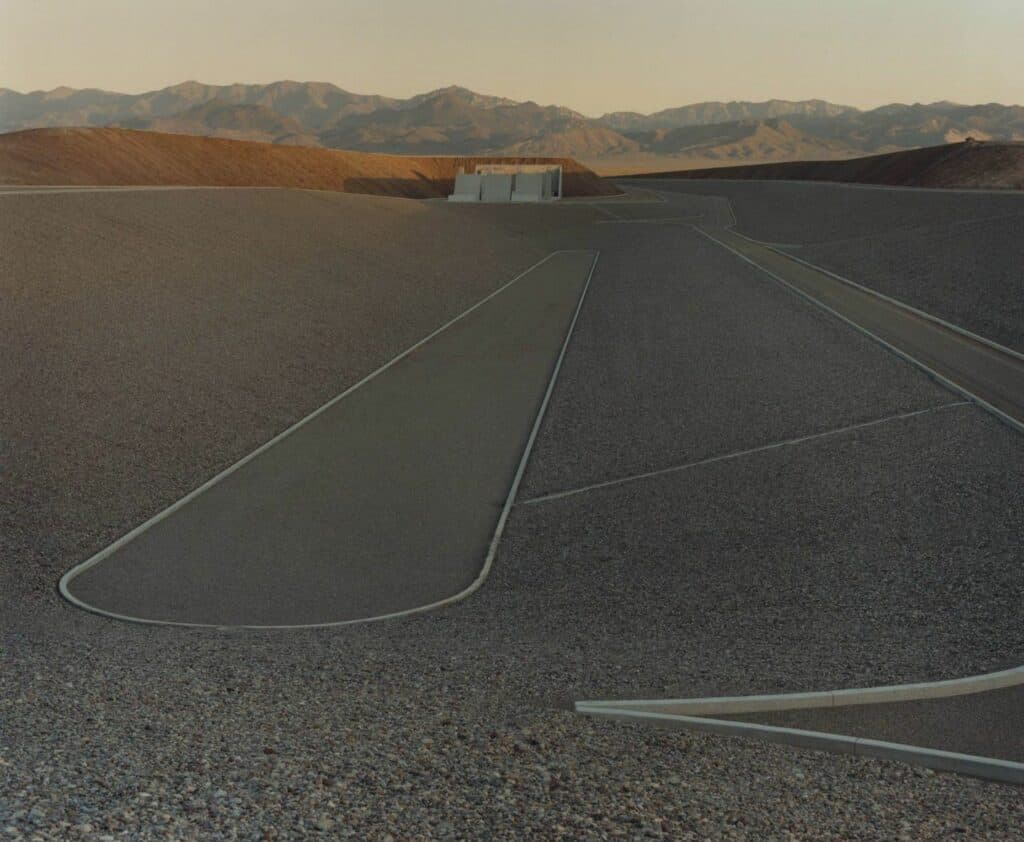
In the middle of a desert in Nevada, geometric structures and colossal sculptures are erected, reappropriating the landscapes of Nevada. For a half century now, Michel Heizer, one of the last living figures who launched the Land Art movement and has an incalculable influence on the world of sculpture and environmental art, has been building an artificial memory of the American civilization. The project began in 1970, when Heizer hired a pilot from Las Vegas to help him find a property in the depths of the desert. Eventually he built a ranch and moved in by the range of Nellis Air Force Base; the Nevada Test Site, where nuclear weapons were detonated during the Cold War; and Yucca Mountain, a proposed burial ground for the nation’s spent plutonium. Heizer acquired his land in Garden Valley in 1972 (with a loan from Virignia Dwan, his chief patron at that time) and became a proper Nevada rancher, building what amounted to an archeological site in his backyard.
3. James Turel, Roden Crater (ca. 2024)
Coconino County, Arizona, USA

The California-born artist has spent the last four decades carving a celestial observatory and light exhibition out of a 400,000-year-old extinct volcano in Northern Arizona’s Painted Desert. Turrel bought the land 1977 with a significant grant from The Guggenheim Museum and began moving 1.3 million cubic yards of earth out of the crater. He then got to work carving out tunnels and apertures, or viewing holes, that illuminate the halls without the use of artificial light. He wanted to construct a controlled environment for the experiencing and contemplation of light. Roden Crater also takes its place within the tradition of American Land Art, being one of the most remote art installations, as it requires an extended journey to visit the work in the middle of the desert, with truly dark night skies. While minimally invasive to the external natural landscape, internally the red and black cinder has been transformed into special engineered spaces where the cycles of geologic and celestial time can be directly experienced. It will constitute a truly culminating phenomenon in world art once it tentatively sets to open its doors in 2024. This is not the only project when James Turel considered erecting ambitious remote art installations, since from another crater in the Netherlands to a vineyard in Argentina, the famed light artist’s works span the globe.
4. The Chinati Foundation
Marfa, Texas, USA

The Chinati Foundation was established with the specific intention to preserve and present to the public permanent large-scale installations by a limited number of artists. The emphasis is on works in which art and the surrounding landscape are inextricably linked. Chinati was originally conceived to exhibit the work of Donald Judd, John Chamberlain and Dan Flavin. Construction and installation at the site began in 1979 with initial assistance from the Dia Art Foundation in New York. The fifteen concrete works by Donald Judd that run along the border of Chinati’s property were the first works to be installed at the museum and were cast and assembled on the site over a four-year period, from 1980 through 1984.
However, the idea of the foundation developed further and its collection was enriched over years, and now the permanent collection has expanded to include Carl Andre, Ingólfur Arnarsson, Roni Horn, Ilya Kabakov, Richard Long, Claes Oldenburg and Coosje van Bruggen, David Rabinowitch, and John Wesley. Each artist’s work is installed in a separate building or outdoor area on the museum’s grounds. In addition to the permanent collection, regular temporary exhibitions feature modern and contemporary art of diverse media.
5. Elmgreen & Dragset, Prada Marfa (2005)
by the US Highway 90 in Texas, USA
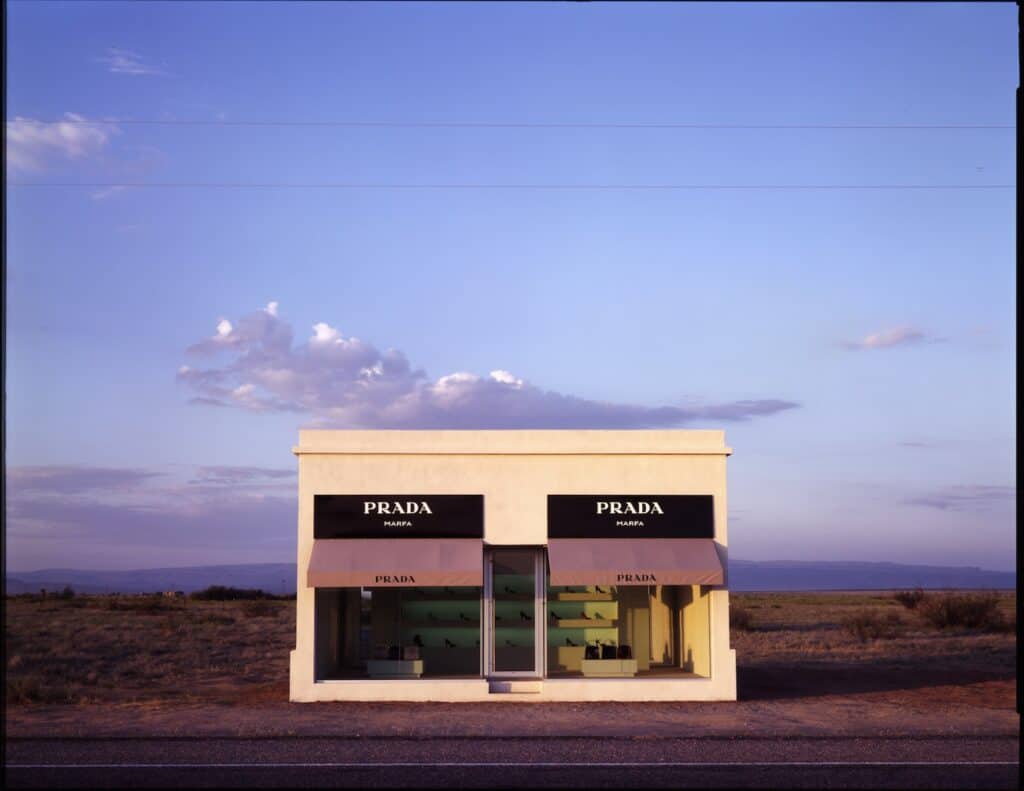
This iconic project—defined by its creator as a ‘pop architectural land art project’—does not link to the surrounding landscape but rather reveals the relationship between the brand Prada and the artists. The structure was not commissioned by the brand, yet, Miuccia Prada has appreciated the concept, allowing the artists to use the brand and has donated a selection of pieces from the Prada Fall/Winter 2005 collection that complement the desert tones of the surrounding environment. Between art installation, museum setup and symbol for fashion enthusiasts, Prada Marfa has over time become a tourist attraction advertised by the many photos posted on social networks by international celebrities like Beyoncé and the iconic street sign indicating the distance to the installation. “We believe that the ideas behind the artwork survive and we hope that this will increase the interest in contemporary art and in the potential of art in general,” affirms Dragset, half of the Swedish artis duo behind the artwork.
6. Nancy Holt, Sun Tunnels (1976)
Great Basin Desert, Utah

One of the few women associated with the male-dominated form of Land Art, Nancy Holt said that the idea for her Sun Tunnels—a work made up of four huge concrete cylinders—came “in the desert watching the sun rising and setting, keeping the time of the earth. Sun Tunnels can exist only in that particular place—the work evolved out of its site.” That site is in a remote valley in the Great Basin Desert, outside the ghost town of Lucin, Utah, west of the Bonneville Salt Flats. The cylinders are arranged in a cross and aligned to frame the sun at sunrise and sunset during the summer and winter solstice and are pierced with smaller holes representing the stars of four constellations: Draco, Perseus, Columba, and Capricorn.
7. Antony Gormley, Inside Australia (2003)
Lake Ballard, Australia
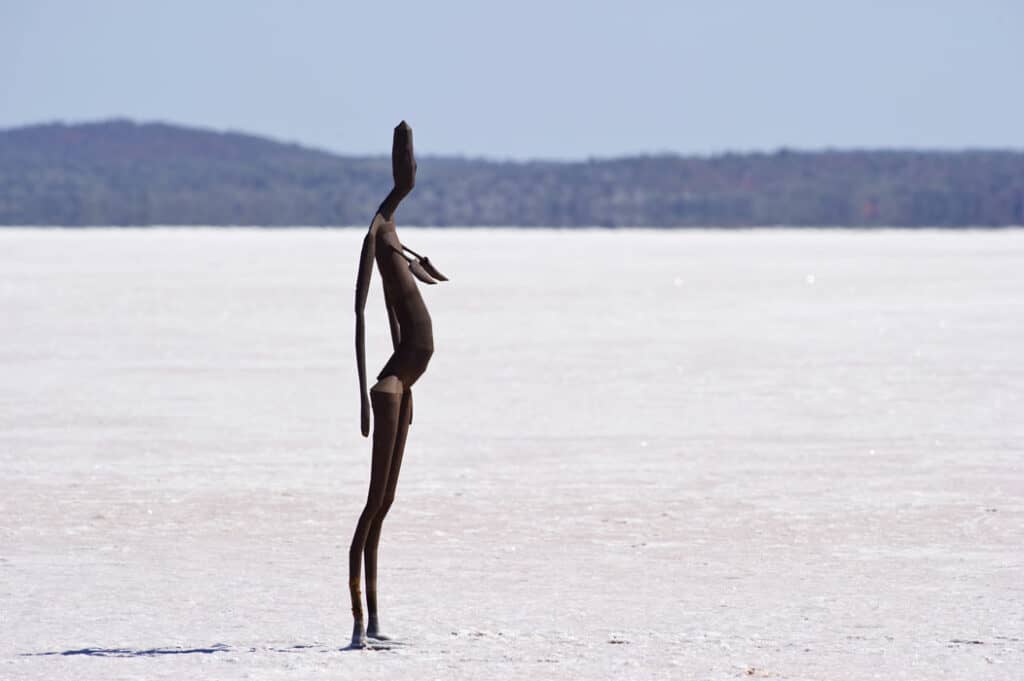
Invited by the Perth International Arts Festival, to make a work to celebrate the festival’s 50th anniversary in 2003 and to repurpose the surrounding landscape, Antony Gormley accepted the challenge. After months of preparation, Gormley supervised the installation of 51 metal figures at Lake Ballard, positioned about 750 metres apart; so wherever a visitor is positioned within the field of the work they seem like tiny, hair-like verticals hanging from the horizon. Gormley scanned the figures of residents of Menzies, the closest town to the installation site, 30 miles away. As people move across the work, they leave a tracery or drawing of connecting lines between the works across the sharp whiteness of the lake. This is a sign of the viewers’ participation in the work which changes, as does the sky, throughout each interval of the year.
8. The Silo Art Trail
Victoria, Australia
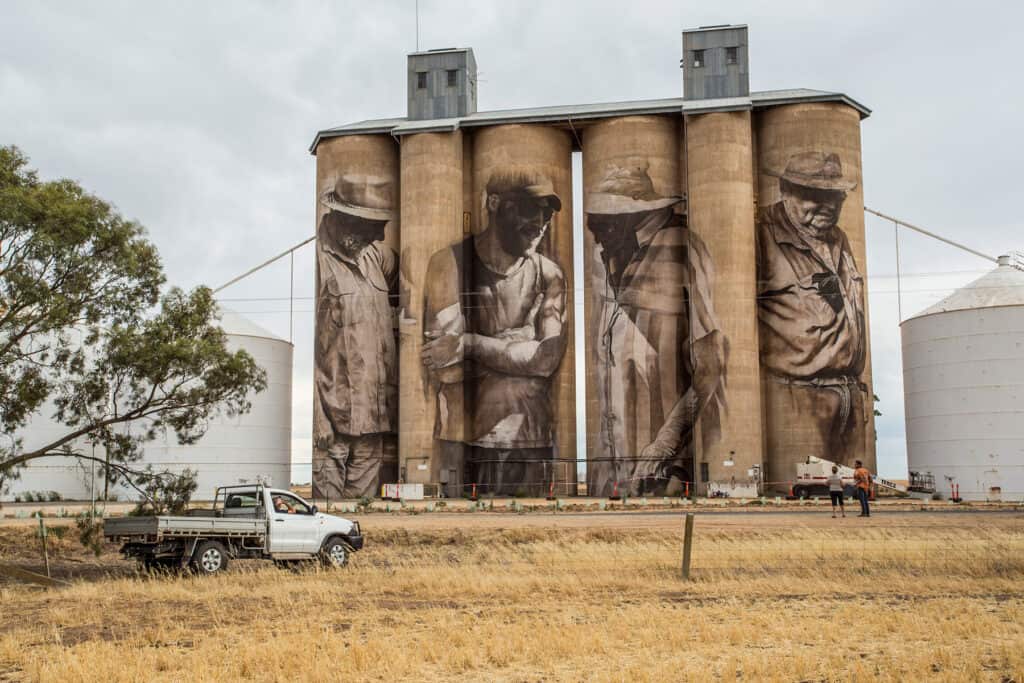
Silos have been dominating the arid Australian landscape for almost a century. The Silo Art Trail, a series of large-scale mural portraits painted onto grain silos, is claimed to be Australia’s largest outdoor gallery. The trail stretches over 200 kilometres in the Wimmera Mallee region; the so-called “wild west” of Victoria, Australia, linking Brim with neighbouring towns Lascelles, Patchewollock, Rosebery, Rupanyup and Sheep Hills. The Silo Art Trail was conceived in 2016 after the success of the first silo artwork in Brim. What started as a small community project led by artist Guido van Helten resulted in widespread international media attention and an influx of visitors to the region and the idea for a trail was born.
9. Peter Zumthor and Louise Bourgeois,
The Steilneset Memorial (2011)
Vardø, Norway
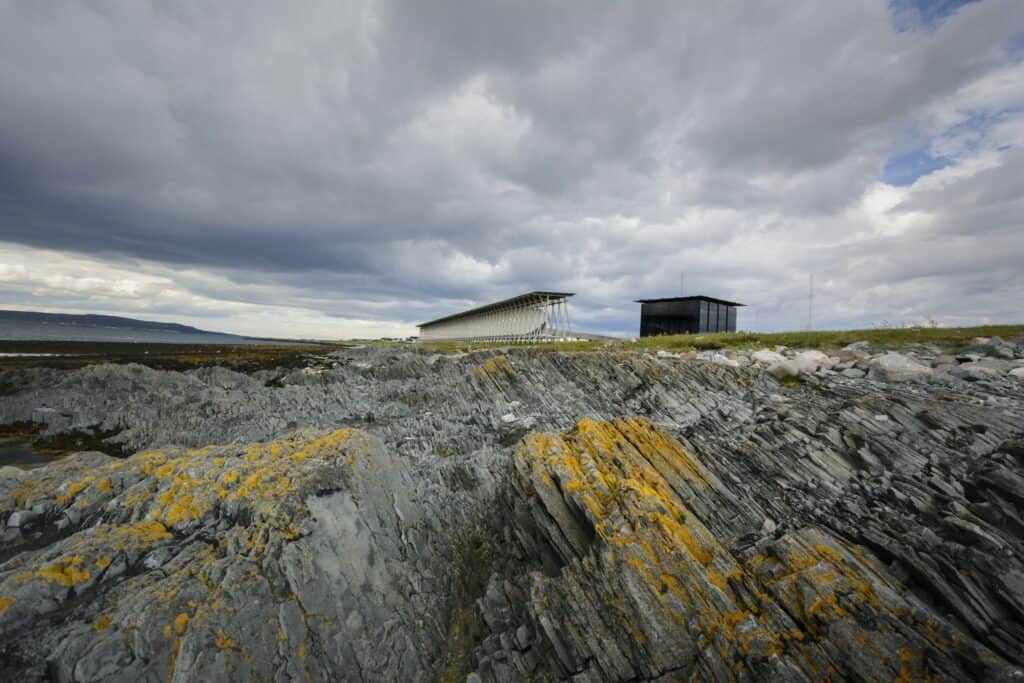
Driving through the northernmost wrinkles of the Norwegian coastline, along the way, one will come across the Steilneset Memorial in the small town of Vardø. A collaboration between the artist Louise Bourgeois and architect Peter Zumthor, the memorial commemorates the 91 people who were burned at the stake as a result of the 17th-century Finnmark witch trials. As befits a site of such historical weight, the memorial is stark and contemplative. Zumthor’s long hallway is lit by 91 bulbs, each next to a small text detailing biographical information about each of the victims, and leads to a glass box, inside which sits Bourgeois’ installation: a circle of mirrors surrounding a burning steel chair. The memorial was Bourgeois’ last major work.
10. Yayoi Kusama, Yellow Pumpkin (1994)
Naoshima Island, Japan
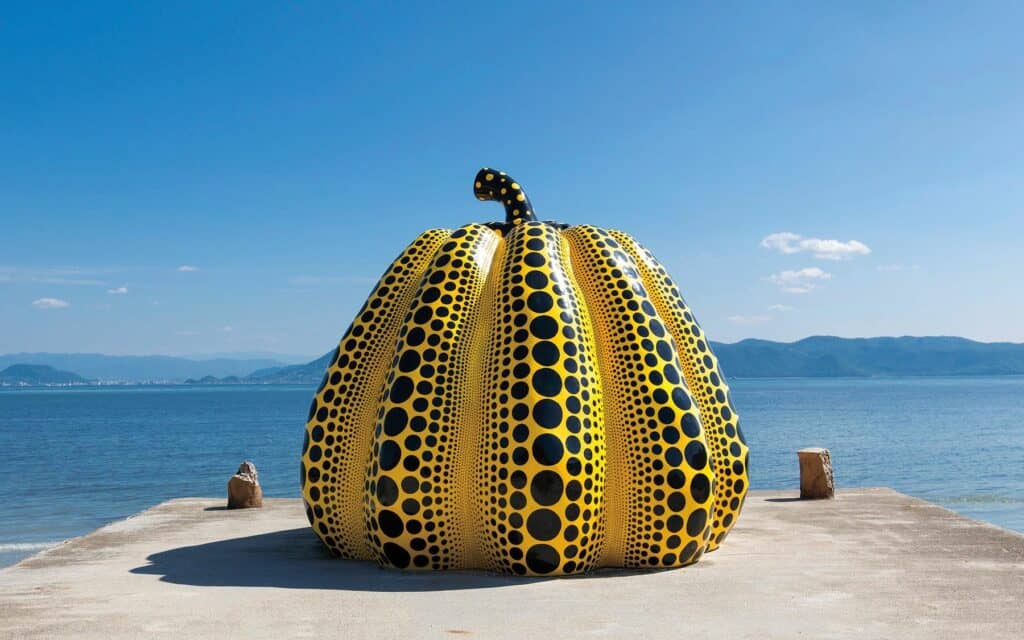
In the last 25 years, the sleepy island of Naoshima in Japan’s Seto Inland Sea has reinvented itself from a declining fishing community to a center for contemporary art and home to the Setouchi Triennale. Installations around the island include old homes that have been converted into art sites after being abandoned by the disappearing local population, a public bathhouse decorated with kitschy objects culled from the designer’s world travels, and two large pumpkin sculptures by the Japanese artist Yayoi Kusama.
Relevant sources to learn more
Artful Locations: Places Made Famous by the Art they Inspired
Top 10 Land Art and Earthwork Pioneers
Environmental Art: Changing Our Habits Or Just Illustrating What We Already Know?
The Rise of the Private Art Museum. Striking Private Art Institutions Around the World
The Dia Art Foundation, a constellation of the most remote art installations.
Michael Heizers Monumental City – feature of the The New Yorker
Female Iconoclasts: Yayoi Kusama
Female Iconoclasts: Louise Bourgeois